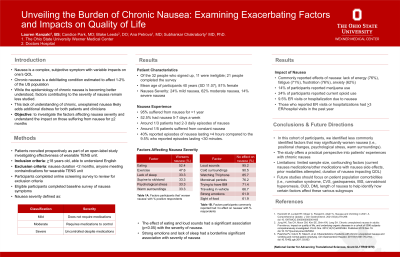Sunday Poster Session
Category: Functional Bowel Disease
P0541 - Unraveling the Complexities: Factors Influencing the Severity of Nausea and Its Impact on Individuals
Sunday, October 22, 2023
3:30 PM - 7:00 PM PT
Location: Exhibit Hall

Has Audio

Lauren Kanzaki, MS
The Ohio State University
Columbus, OH
Presenting Author(s)
Lauren Kanzaki, MS1, Candice Park, MD2, Blake Leeds, DO3, Ana Petrova, MD4, Kebire Gofar, 1, Subhankar Chakraborty, MD, PhD1
1The Ohio State University, Columbus, OH; 2The Ohio State University Wexner Medical Center, Grandview, OH; 3OhioHealth Doctors Hospital Internal Medicine Residency, Columbus, OH; 4Ohio State University, New Albany, OH
Introduction: Chronic nausea is a debilitating condition estimated to affect about 1-2% of the US population. However, the mechanism of chronic nausea is poorly understood. The objective of our study was to investigate the factors affecting severity of nausea and its effect on sufferers.
Methods: Patients were recruited prospectively as part of an open-label study investigating the effectiveness of a wearable TENS unit in nausea. Participants were at least 18 years old and suffering from nausea for 2 months or more. Participants completed a survey about their nausea symptoms. Nausea was categorized as absent, mild (did not require any medications), moderate (required medications to control), and severe (uncontrolled by medications).
Results: Thirty-two people signed up for the study, 21 completed the survey. The mean age of the participants was 40 years (SD 11.07 years), and 81% were female. Majority (62%) of participants reported moderately nausea. Most (95%) had suffered from nausea for more than 1 year. The majority had nausea 5-7 days a week (52.5%). Nearly a third had 2-3 episodes of nausea daily, and one in five suffered from constant nausea. About 40% reported that an episode of nausea lasted more than 4 hrs, and only a minority (9.5%) reported that they lasted less than 30 minutes. Eating, exercise, changing position from supine to sitting/standing, lack of sleep, psychological stress, and warm surroundings were the factors most frequently reported to worsen nausea. Loud sounds, cold surroundings, watching TV or a phone screen, trying to have a bowel movement, and menstrual periods were most frequently reported as having no effect on nausea. The effect of eating and loud sounds on nausea correlated significantly with the severity of nausea. The most common effects of nausea were a lack of energy (76%), fatigue (71%), frustration (76%), and anxiety (62%). 14% patients reported using marijuana, 9.5% reported ER visits or hospitalization due to nausea in the last year, and 24% reported current opioid use. Those who reported ER visits or hospitalization reported 3 or more such episodes in the past year. There was a significant correlation between certain factors (e.g., the thought of food with the sight or smell of food) and their effect on nausea.
Discussion: We present a comprehensive evaluation of exacerbating and relieving factors in chronic nausea and its impact on people's life. This will help us investigate the mechanisms of chronic nausea and novel strategies to mitigate it.
Disclosures:
Lauren Kanzaki, MS1, Candice Park, MD2, Blake Leeds, DO3, Ana Petrova, MD4, Kebire Gofar, 1, Subhankar Chakraborty, MD, PhD1. P0541 - Unraveling the Complexities: Factors Influencing the Severity of Nausea and Its Impact on Individuals, ACG 2023 Annual Scientific Meeting Abstracts. Vancouver, BC, Canada: American College of Gastroenterology.
1The Ohio State University, Columbus, OH; 2The Ohio State University Wexner Medical Center, Grandview, OH; 3OhioHealth Doctors Hospital Internal Medicine Residency, Columbus, OH; 4Ohio State University, New Albany, OH
Introduction: Chronic nausea is a debilitating condition estimated to affect about 1-2% of the US population. However, the mechanism of chronic nausea is poorly understood. The objective of our study was to investigate the factors affecting severity of nausea and its effect on sufferers.
Methods: Patients were recruited prospectively as part of an open-label study investigating the effectiveness of a wearable TENS unit in nausea. Participants were at least 18 years old and suffering from nausea for 2 months or more. Participants completed a survey about their nausea symptoms. Nausea was categorized as absent, mild (did not require any medications), moderate (required medications to control), and severe (uncontrolled by medications).
Results: Thirty-two people signed up for the study, 21 completed the survey. The mean age of the participants was 40 years (SD 11.07 years), and 81% were female. Majority (62%) of participants reported moderately nausea. Most (95%) had suffered from nausea for more than 1 year. The majority had nausea 5-7 days a week (52.5%). Nearly a third had 2-3 episodes of nausea daily, and one in five suffered from constant nausea. About 40% reported that an episode of nausea lasted more than 4 hrs, and only a minority (9.5%) reported that they lasted less than 30 minutes. Eating, exercise, changing position from supine to sitting/standing, lack of sleep, psychological stress, and warm surroundings were the factors most frequently reported to worsen nausea. Loud sounds, cold surroundings, watching TV or a phone screen, trying to have a bowel movement, and menstrual periods were most frequently reported as having no effect on nausea. The effect of eating and loud sounds on nausea correlated significantly with the severity of nausea. The most common effects of nausea were a lack of energy (76%), fatigue (71%), frustration (76%), and anxiety (62%). 14% patients reported using marijuana, 9.5% reported ER visits or hospitalization due to nausea in the last year, and 24% reported current opioid use. Those who reported ER visits or hospitalization reported 3 or more such episodes in the past year. There was a significant correlation between certain factors (e.g., the thought of food with the sight or smell of food) and their effect on nausea.
Discussion: We present a comprehensive evaluation of exacerbating and relieving factors in chronic nausea and its impact on people's life. This will help us investigate the mechanisms of chronic nausea and novel strategies to mitigate it.
Disclosures:
Lauren Kanzaki indicated no relevant financial relationships.
Candice Park indicated no relevant financial relationships.
Blake Leeds indicated no relevant financial relationships.
Ana Petrova indicated no relevant financial relationships.
Kebire Gofar indicated no relevant financial relationships.
Subhankar Chakraborty: Coloplast – Consultant. Medtronic – Consultant.
Lauren Kanzaki, MS1, Candice Park, MD2, Blake Leeds, DO3, Ana Petrova, MD4, Kebire Gofar, 1, Subhankar Chakraborty, MD, PhD1. P0541 - Unraveling the Complexities: Factors Influencing the Severity of Nausea and Its Impact on Individuals, ACG 2023 Annual Scientific Meeting Abstracts. Vancouver, BC, Canada: American College of Gastroenterology.
